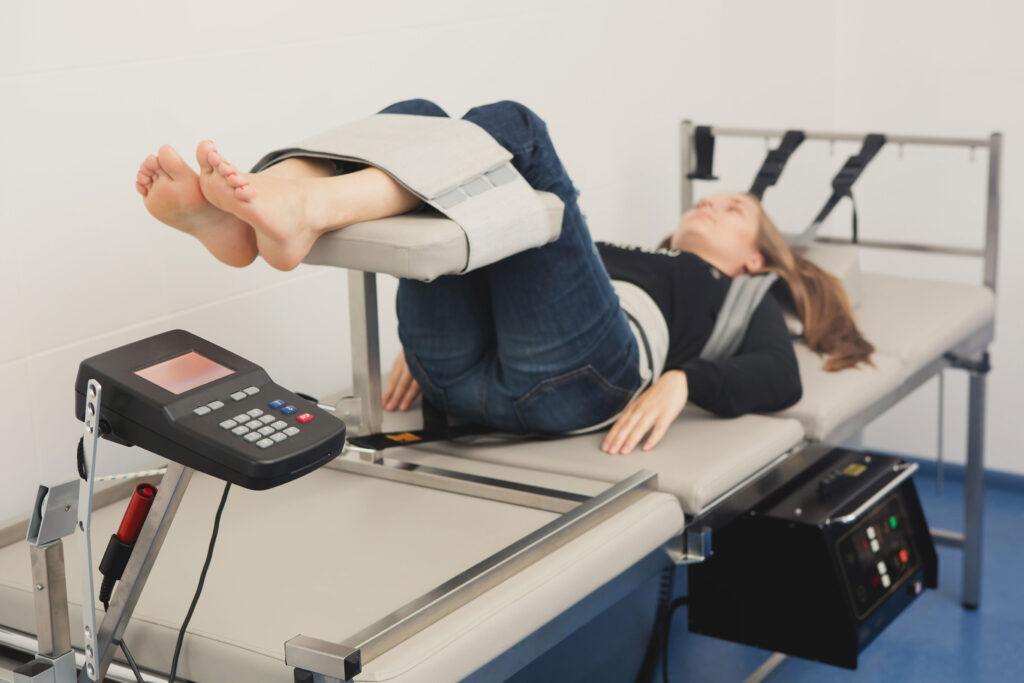MINIMALLY INVASIVE LUMBAR DECOMPRESSION
Minimally Invasive Lumbar Decompression is a relatively new method of treating moderate to severe lumbar spinal stenosis (LSS). Spinal Stenosis is a condition causing the narrowing of the spinal canal resulting in pain in the lower part of the back.
The procedure involves a very small incision that helps relieve your back pain so that you can quickly return to your normal, daily activities. The aim of minimally invasive lumbar decompression surgery is to stabilize the vertebral bones and spinal joints. This surgery also relieve pressure being applied to the spinal nerves that often a result of conditions such as spinal instability, bone spurs, herniated discs, scoliosis or spinal tumors.
In comparison to open spine surgery, minimally invasive surgical approaches can be faster, safer, and require less recovery time. In Due to the reduced trauma to the muscles and soft tissues in comparison to open procedures, the potential benefits are:
- Better cosmetic results from smaller skin incisions.
- Less loss of blood after surgery.
- Less risk of muscle damage.
- Less or no cutting of the muscle.
- Less or reduced risk of infection and postoperative pain.
- Lesser rehabilitation and faster recovery from surgery.
- Reduced support of pain medications after surgery.

WHAT IS MINIMALLY INVASIVE LUMBAR DECOMPRESSION PROCEDURE?
The procedure of Minimally Invasive Lumbar Decompression would require a small incision. The procedure is normally performed under general anesthesia, such as epidural or spinal anesthesia as per surgeon preference.
Treating LSS through minimally invasive lumbar decompression focuses on removing overgrown ligament and bone at the lower part of the spine. You enjoy relief from pain along with improved mobility. This procedure also prevents spinal instability as well as avoids the use of invasive fusion surgery.
LSS is a well-recognized condition, which is characterized by narrowing of the spinal canal and compression of the nerve fibers that emerge from the spinal cord. You can experience a variety of symptoms like pain and tingle in the buttocks and legs with associated numbness.
WHY YOU MIGHT NEED A MINIMALLY INVASIVE LUMBAR DECOMPRESSION?
Your doctor suggests this surgery if you have a herniated disc in your lower back that is causing symptoms such as:
- Weakness,
- Pain, or
- Tingling.

Lumbar discectomy may not always be used to treat all cases of back pain. Your healthcare provider might advise the surgery if other treatments do not provide relief. Other treatments may include physical therapy and anti-inflammatory medicines.
The healthcare provider would also discuss the risks and benefits of minimally invasive surgery as compared to open surgery. Minimally invasive surgery may lead to less pain and faster recovery.
WHAT ARE THE BENEFITS AND DISADVANTAGES OF MINIMALLY INVASIVE LUMBAR DECOMPRESSION?
Minimally invasive lumbar decompression might be right for you if other treatment options do not provide relief in your symptoms. Initial treatment options include physical therapy and medication that are often quite effective.
But if you do not get relief from your symptoms or they are getting worse, surgery may be the next step. But, the important question is – which kind? Some of the advantages of minimally invasive lumbar decompression include:
- Less Traumatic: During surgery, the condition being treated, involves recovery from the muscle and tissue damage caused by the procedure. But, minimally invasive surgery involves little to no muscle cutting. This allows your body to focus on healing the disc, nerves, and vertebrae and not the muscle.
- Less Painful: Smaller incisions and less damage mean that you experience far less pain when you come out of surgery and for the days and weeks ahead. This also means that you need less pain medication following surgery, decreasing the potential for becoming dependent on it.
- Faster recovery: The treatment’s main goal is to get rid of the pain you’ve been experiencing for months or years. In the case of open surgery you experience increases pain with a long recovery time including long-term rehabilitation. But with minimally invasive surgery you experience less pain with a shorter recovery time. You get back into your regular activities faster.
- Fewer complications: All surgical procedures involve risks, but minimally invasive spine surgery reduces the potential complications to only two such as possible reaction to anesthesia and possible infection at the incision site.

With minimally invasive lumbar decompression surgery, you bypass problems including:
- Excess blood loss
- Pain medication dependency
- Large scars
- Postoperative pain
- Physical therapy challenges
However, there are also certain disadvantages of Minimally Invasive Lumbar Decompression, including:
- The main disadvantage is its newness, as it hasn’t been around as long as traditional surgery and advanced developments are yet to be made.
- It requires a higher level of training, and insufficient training can lead to complications.

The complexity of the operation may take you longer to recover than if you had a traditional surgery. Alike other surgery, there are risks and complications you need to be aware of before starting the procedure. Your doctor would brief you about the possible complications post the surgery. They would also brief you on the necessary measures that will help avoid potential risks that include:
- Bleeding
- Blood clots
- Pseudarthrosis
It is more technical and only a handful of surgeons have the expertise to perform the procedure. After this procedure, you will need to follow the specific post-operative instructions provided by your surgeon. These may include:

- Light physiotherapy.
- Ample rest for a few days
- Scheduling and attending follow-up appointments.
In this way, your doctor is aware of your spine’s healing progress and can recommend the next steps. These disadvantages are present in the case of traditional surgery also. Therefore, it is important to talk to your doctor before you proceed.
OUTLOOK
Minimally invasive spine surgery presents a lot of benefits but it does not mean that it is more efficient or better than traditional surgical treatment. Your doctor will always guide you through your journey to a healthy spine and would provide you with all possible treatment options.
It is correct to say that, not all conditions can be treated with minimally invasive surgery; sometimes open surgery is necessary. But the doctor would suggest minimally invasive surgery whenever possible as it offers significant benefits.
PEOPLE ALSO READ:
If you or anyone you know is suffering from spinal problems, our expert providers at Specialty Care Clinics will take care of your health and help you recover.
Call us on (469) 545-9983 to book an appointment with our specialists.
